Ecuador, a jewel of 109,483 square miles in northwestern South America, sits proudly on the Equator between Colombia and Peru. This enchanting land is home to the majestic Northern Andes, the verdant edges of the Amazon Basin, and a Pacific coastline caressed by both warm and cold ocean currents. Farther out, 600 miles offshore, the legendary Galapagos Islands await—a world of wonder and discovery.
From the towering peaks of the Andes to the vibrant biodiversity of the Galapagos, Ecuador promises an experience unlike any other. Here, ancient cultures thrive alongside stunning natural beauty, inviting you to explore, connect, and marvel. Whether hiking among volcanic landscapes, wandering through historic colonial cities, or encountering wildlife found nowhere else on Earth, Ecuador will leave you inspired and transformed.
Different parts of the island have varied origins, some with fresh lavas and spatter cones and others consisting of eroded tuff formations. Baltra Island used to be a US Air Force Base during World War II.
American soldiers in Baltra Island patrolled the nearby waters of the Pacific Ocean, including the entrance to the Panama Canal, for enemy aircraft carriers, warships, and submarines. When the war ended, the facilities in Baltra Island were handed over to the Ecuadorian Government.
Up until 1986, Baltra Island was home to the only airport in the Galapagos Islands. The airport now shares flights to the Galapagos with the San Cristobal Island airport, but it still receives the majority of flights from the mainland. Most cruise operators also start their cruise operations from Baltra Island. Also, because of its proximity to the largest port town in the Galapagos Islands (Puerto Ayora), most tourists who do island-based tours choose to arrive at the airport on Baltra Island.



Santa Cruz Island is composed of two parts: a younger and larger portion is formed by many volcanic cones and basaltic lavas, while the older part is a narrow, 10-mile strip of land along the northeastern coast and consists of uplifted submarine lava flows and tuffs.
Santa Cruz Island is the second-largest island in the Galapagos and something of a hub for the archipelago. Puerto Ayora, located in the southeast of this large, round volcanic island, is the economic center of the Islands.
Puerto Ayora is home to both the Galapagos National Park Service Headquarters and Charles Darwin Research Station, the center of the great restorative efforts taking place in the park, a UNESCO World Heritage site.
A highlight of any trip is a visit to Santa Cruz Highlands, where the dry coastal vegetation transitions to lush wet fields and forests overgrown with mosses and lichens. Our destination is the Tortoise Reserve, where we will have chances to track and view these friendly and ancient creatures in their natural settings. This extends to the adjacent pasturelands, where farmers make some profits by allowing visitors into their farms in exchange for payment. The best time to see tortoises here is during the cold or dry season from June through December. Another nearby attraction is the highland lava tunnels. Some of them offer easy access through wooden stairways that descend to the mouth of their arched cave entrances. From there, one can make their way into the caves underground along the cool, dimly lit naturally formed passages with their fascinating rock formations. The tunnels make for a relatively easy and exciting hike. You should bring along non-slip footwear and some hikers prefer to use a flashlight.



As previously described



As previously described



Santiago Island has a volcanic landscape and it is common to see fur seals, flamingos, and hawks. Another important feature of Santiago Island is that it has almost all the vegetation zones, from arid to humid. Still, they have been severely affected by the intense browsing of introduced goats.
Santiago Island offers numerous scoria and tuff cones; extensive recent lava flows on the east and south of the island. One major volcano dominates the western side, which is thickly vegetated and highly eroded.
Just across a narrow channel west of Bartolome Island lies Sullivan Bay on Santiago Island. This landing offers one of the most outstanding volcanic sites in the Galapagos. Just over a century ago, the island gave birth to a field of lava called pahoehoe (“rope-like” in Hawaiian), which gleams like a gigantic obsidian sculpture. It is stirring to imagine the once-molten lava lighting up the earth, flowing into the sea, and sending plumes of superheated steam skyrocketing into the air. The flow gave birth to the new land as it engulfed vegetation, leaving some plants forever etched into the earth.
Today the flow stands as a gallery of abstract shapes resembling braids, curtains, and swirling fans. Brightly colored “painted locusts” and “lava lizards” punctuate the black volcanic canvas, as does the occasional finger of lava cactus and spreading carpetweed. Looking back across the bay from the source of the flow, a cinder cone of reddish lava, you are treated to a view of Pinnacle Rock nearby Bartolome Island.
On the northwestern side of Santiago Island in James Bay, which offers access on a Galapagos cruise to three unique sites, Puerto Egas, Salt Mine, and Espumilla Beach. The first landing, Puerto Egas, is the most visited area and begins with a wet landing on a black beach. With intriguing eroded rock formations inland, the trail crosses the dry interior eastward and continues along the shoreline, where two different types of lavas merge into unreal scenery. There we find the so-called Fur seal Grottos, the only place during your visit that allows you to see these beautiful marine mammals during a land excursion. Darwin describes his visit to Santiago Island and James Bay in Voyage of the Beagle.
From the black beach at Santiago Island, it is possible to experience one of the most exuberant snorkeling sessions during your visit.



Snorkeling at Chinese Hat provides one of the best opportunities in the archipelago to see Galapagos Penguins, Sea Lions, Reef Sharks, and Green Sea Turtles all in one spot. Sea Lion pups swim in a cove that is secluded around the Chinese Hat where they are protected from predators and the waves, while their mothers are out at sea looking for food. You will also have a chance to swim and play with these sea lions as they maneuver like torpedoes around the underwater rock formations and perform loops and blow bubbles to amaze the snorkeling spectators. You will also have a chance to swim with zig-zagging penguins that are chasing small schools of fish, as well as with Green Sea Turtles that are slowly cruising the same waters in search of an algae bed to feed on. White-tip reef sharks are also commonly spotted here as they oxygenate their blood by slowly cruising around the sandy bottom.



As previously described



By definition, this is a bird Island! Also known as Tower Island, this island is home to red-footed boobies, masked boobies, frigate birds and swallow-tailed gulls nesting. Moreover, red-billed tropicbirds nest on the cliffs and short-eared owls are often spotted. The vegetation of Tower Island is typical of the Arid Zone, and the tree called palo santo (holy stick) is small in size and abundant.
Genovesa Island lava originated primarily from a crater found in the center of the island, forming a shield volcano. The crater is circular, approximately 2000 feet wide at the rim and 200 feet deep, with a lake 1150 feet across on its floor.
Genovesa Island is possibly one of the most exciting Islands of the archipelago to visit on a Galapagos cruise! It could serve as a film set for a secret submarine base! The southwestern part of Tower Island is an ocean-filled caldera ringed by the outer edges of a sizeable and mostly submerged volcano. The island sits to the northeast, somewhat removed from the Galapagos archipelago. It is also known as "Bird Island," a name it lives up to in a spectacular way. Landing on the white coral sands of Darwin Bay and walking up the beach, you will be surrounded by the bustling activity of magnificent frigate birds.
Puffball-chicks with their proud papas - who sport their bulging scarlet throat-sacks - crowd the surrounding branches, while both yellow-crowned and lava herons feed by the shore. Farther along, you will discover a stunning series of sheltered pools set into a rocky outcrop, forming another natural film set. A trail beside the pools leads up to a cliff overlooking the caldera, where pairs of swallow-tailed gulls, the only nocturnal gulls in the world, can be seen nesting at the cliff's edge. Lava gulls and pintail ducks ride the sea breezes nearby.
Across the bay is Prince Philip's Steps, named for a visit by the British Monarch in 1964. The 81-foot stairway leads to a narrow stretch of land that opens out onto the plateau surrounding Darwin Bay and extends to form the north side of the island. Red-footed boobies wrap their webbed feet around branches to perch in the bushes, and, in contrast, their "Nazca booby" cousins dot the surface of the scrublands beyond. Crossing through the sparse vegetation, you will come to a broad lava field that extends towards the sea-this forms the north shore. Storm petrels flutter out over the ocean in swarms, then return to nest in the cracks and tunnels of the lava field, where their predator, the short-eared owl, is a frequent visitor.



Darwin Bay is a nesting spot for many marine birds. Puffball chicks of Great frigate birds and their proud papas crowd the surrounding branches, while yellow-crowned herons and lava herons feed by the shore. Watch your step for marine iguanas, lava lizards and Galapagos doves that blend with the trail. Swallow-tailed gulls, the only nocturnal gulls in the world, can be seen nesting at the cliff’s edge. Lava gulls and pintail ducks ride the sea breezes nearby.
As previously described


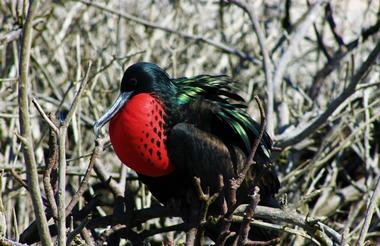
Santa Fe Island is one in which lavas were extruded beneath the sea and later were uplifted (although recent evidence suggests subsequent sub-aerial activity); the island is crossed by several parallel cliffs formed by fault activity. This island has lavas of 3.9 million years of age, making it the oldest island successfully dated in the archipelago.
Santa Fe Island besides offering one of the more beautiful and sheltered coves in the islands it also has endemic species of land iguana, endemic species of rice rat, subspecies of cacti, beautiful landscape. Its turquoise lagoon is protected by a peninsula of tiny islets forming an ideal anchorage. The island lies southeast of Santa Cruz Island within sight of Puerto Ayora. Geologically it is one of the oldest islands in the archipelago and for many years, was thought to be a product of an uplift event. Through satellite imagery, it has been possible to determine the island's volcanic origins.
A Santa Fe Galapagos travel adventure includes a wet landing on a sandy white beach that brings visitors into contact with one of many sea lion colonies. Bulls contend for the right of being the Beach Master, while smaller males mask as females to make stealthy mating moves. Galapagos hawks are often easily approached, perched atop salt bushes, and an ascending trail leads toward the cliffs, where a dense thicket stands to the inland side. The cliffside provides an expansive view of the ocean. The giant prickly pear cactus found here live up to their name, with tree-sized trunks!
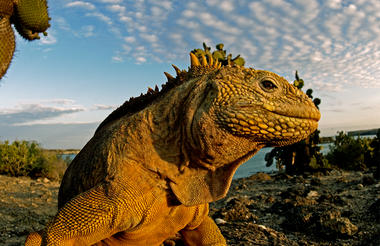
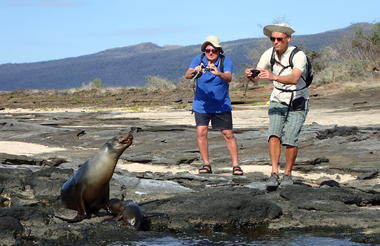

As previously described
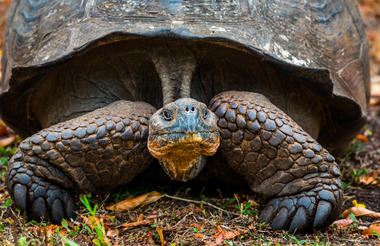
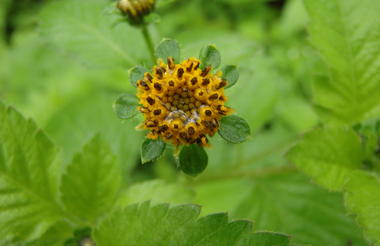
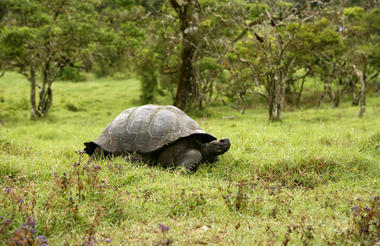
As previously described
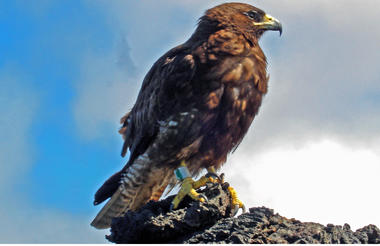
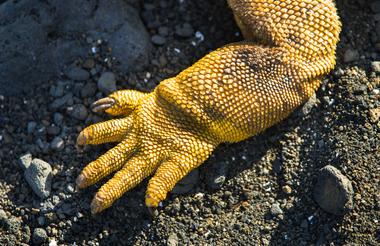
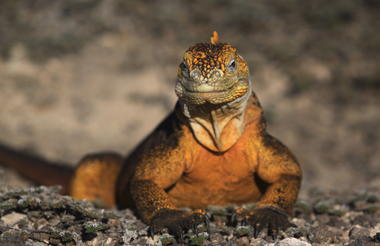
As previously described

